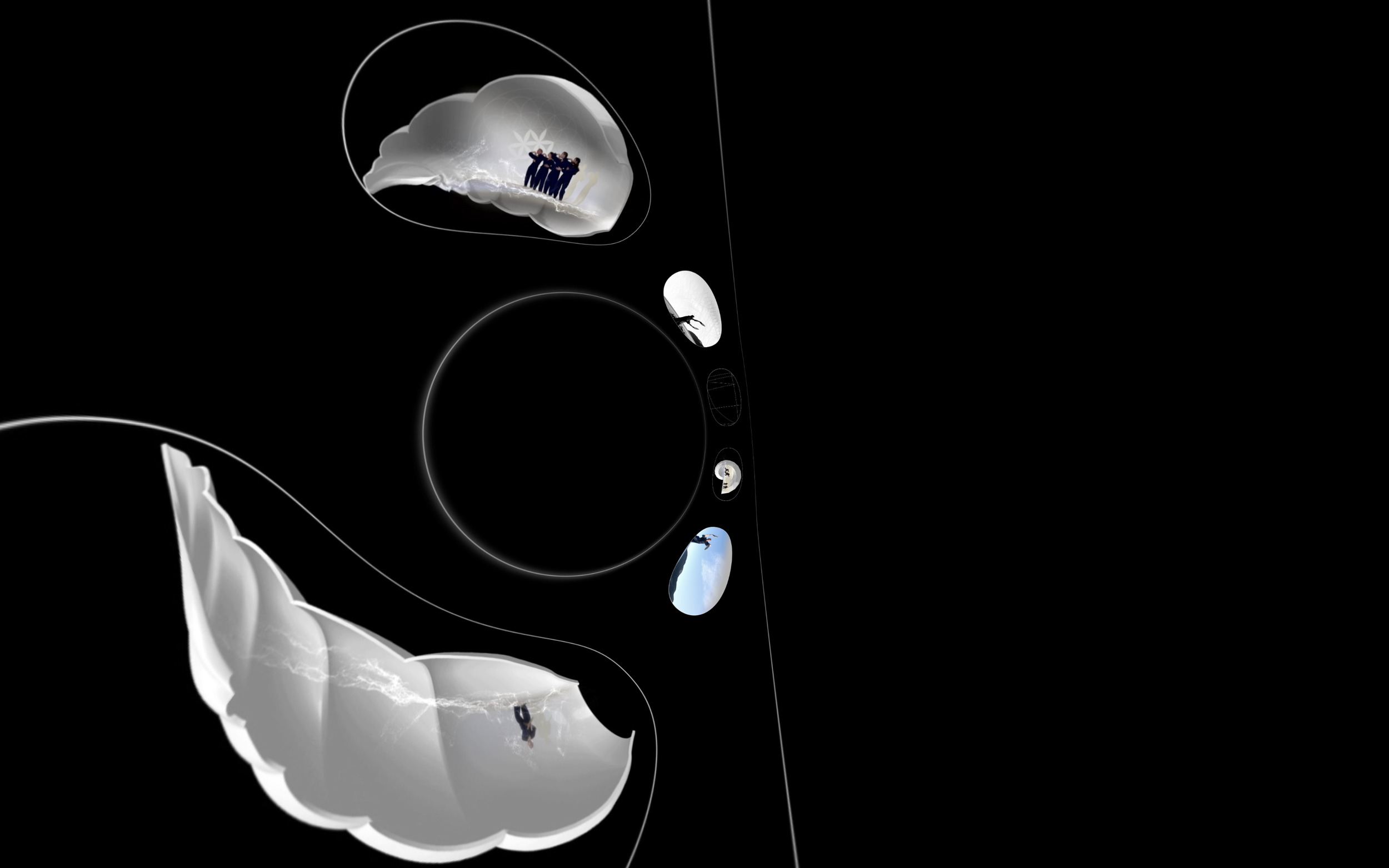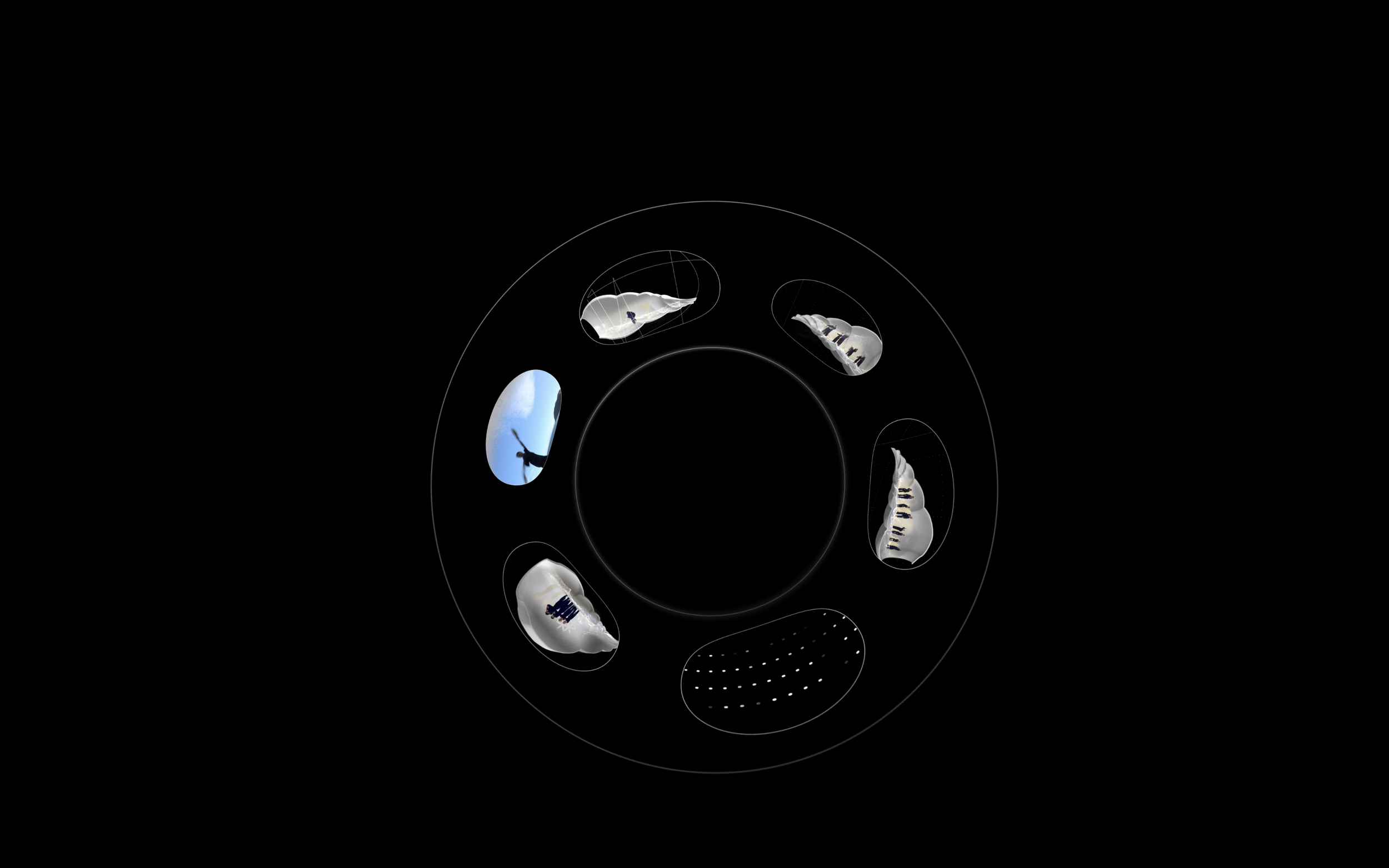PŌTAKA NAUTILUS
Pōtaka Nautilus is a multi-modal project. Digital film fragments act as conduits for stories in dance, sound, and light. Spatially augmented journeys emanate from the screen as miniature cinematic poems supported by taonga pūoro (traditional Māori instruments), sampled cello and electronics. Woven and digital representations evoke concepts of shelter, navigation and travel. The spiral is one of our most ancient and enigmatic symbols. Images of galaxies show the spiral in myriad continuous expansions towards the infinite. In nature, spirals are everywhere, from shells to the movement of electrons, from fingerprints to the shape of hurricanes, from the vortex of a whirlpool to the flight of birds of prey. The spiral is an age-old intuitive symbol of spiritual development and our identity with the universe. Spirals often appear engraved on the stone of the monuments that were illuminated during the solstice and the equinox. This primordial symbol unites cultures and peoples all over the world, from the Northern Europe of the ancient Celts to South America, from Africa to the Mediterranean and throughout Asia and the Pacific.
Concentric rings of the spiral expanding from a central point are a symbol of growth and rebirth; a feminine symbol linking to the generative force of the universe and to the mystery of birth. The koru, used in Māori art, is based on the shape of an unfurling fern frond. Spirals convey perpetual movement with the coil suggesting a return to the point of origin. The spiral and the koru signal identity with the universe and demonstrate the evolutionary nature of the journey. Pōtaka tā are spinning tops that revolve in a vertical direction, a process called precession. As the spin of the top slows, we see this precession become faster, and then begin to bob up and down as it precesses further - the rotation is all centred on the spiral.
In Pōtaka Nautilus the shell is representative of a haven, a refuge space. This project offers a mosaic of dance, sound and light that can be seen as portals of time through multiple lenses. Audiences are transported into a world suspended between timelessness and the here and now. Digital dancers appear cocooned by oscillating ovoid forms - opening and closing as dimensional thresholds.
Traditional Māori raranga weaving (with harakeke or flax), and Māori musical instruments form significant parts of the creative dialogue that connect us to natural elements such as earth and water, air and sunlight. This project binds together the energy of filmed dance performance with digital media, and offers a virtual kaleidoscope of solos, duos, quartets and octets in dance. Digital sound shells carry the dancers as virtual stages, gliding through space, navigating coastal zones of Aotearoa New Zealand. The pūpū harakeke (flax snail shell) is played by taonga pūoro artists as a flute. This shell form is represented in our film design to evoke travel and navigation (a waka or ship), a wharenui or sanctuary, and as portals. Kōauau pūpū harakeke and pūtātara (trumpet) shell timbres heard in the soundscape are emotional. Taonga pūoro connects us to bodies of land and water, to breath and dance, to signify transience within the natural world. Everything is movement. Thich Nhat Hahn said that the real insight of inter-being was to see humanity as part of Earth, that we are part of the planet. To see beyond the illusion of separateness, we must comprehend that Papatūānuku (Mother Earth) is not just our environment. Our DNA is galactic, we carry Papatūānuku within us. Knowledge our ancestors possessed was very different to what we know about our world today. We dream, we create ideologies and systems - this project looks at our will to survive, to be integral.
Pōtaka Nautilus is constructed from moments syncopating and retuning as a series of pulses. Very slow passages feel almost glacial in their momentum. The seed of movement resides within stillness as a fundamental potential. The mountains of Te Wai Pounamu (South Island of Aotearoa New Zealand) can be seen in the distance across the sea. Dance, visuals and sound combine to glimpse the human being in motion as part of an eternal cycle. As if reaching into the fibres of space - Pōtaka Nautilus pictures a living breathing cosmos, elevated by the shared breath of dance and the sound of taonga pūoro.
Heartfelt thanks to Patxi Araujo of La Universidad del País Vasco/Euskal Herriko Unibertsitatea. Acknowledgements and thanks to Festival After Cage 2023, ASOCIACIÓN E 7.2, Juan José Eslava Cabanellas and Museo de Navarra, Pamplona, Spain. Special thanks to the College of Creative Arts Toi Rauwhārangi, Massey University Te Kunenga ki Pūrehuroa, the NZPQ23 Ka emiemi team, and The Arts Centre Te Matatiki Toi Ora, Ōtautahi, Christchurch, New Zealand (Matariki 2024 Festival). Ngā mihi nui Creative New Zealand toi Aotearoa for supporting the realisation and sharing of this collaboration including our interactive exhibition in Osaka, Japan during October 2024, and in 2025 with the evolution of this project as live performance double bill alongside PEPE for Dunedin Arts Festival - featuring taonga pūoro master artists Ariana Tikao, Mahina Kingi-Kaui, Alistair Fraser and Dr Ruby Solly activating large format live keyed film projections. In October 2025 Pōtaka Nautilus was paired with PEPE as a new performance event participating in World Stage Design’s Scenofest programme at the Sharjah Performing Arts Academy. Mahina Kingi-Kaui joined Daniel Belton onstage to deliver the work incorporating live taonga pūoro, live soundlandscaping with river stones, and live keyed large format film projection.
Daniel Belton and Good Company Arts
NAUTILUS VR EXPERIENCE
360 VR Movie - Can be played on Desktop browser or with the Vimeo mobile app. Winner Best VR Experience Seoul International Short Film Festival 2024.
Pōtaka Nautilus (Film Projection + VR + Giclée Art Prints + Harakeke Weaving Immersive Exhibition) at Museo de Navarra for Festival After Cage, Spain; October 2023. Virtual Webcast Good Company Arts; November 2023 (Honorable Mention International Sound Future Awards New York* Semi-Finalist Rome International Short Festival* Semi-Finalist Dubai Independent Film Festival* Official Selection ROLLOUT Dance Film Festival Macao (Museo Edition)* Official Selections Marbella Movie Magic Malaga (Webcast)* Official Selection Amsterdam World Canvas Film Festival* Official Selection Dream Vision International Film Festival (VR)* Winner Best Web and New Media Istanbul Movie Awards (VR)* Official Selection Chroma Art Film Festival Miami (VR)* Semi-Finalist St. Louis Film Awards Missouri* Semi-Finalist Serbest International Film Festival (Webcast)* Finalist Ecovision Global Film Festival Sydney (Webcast)* Winner Best Web and New Media Istanbul Movie Awards (Webcast)* Winner Best VR Experience Seoul International Short Film Festival 2024*
Pōtaka Nautilus (NZPQ23 June 2023; Pūpū Harakeke Edition): Winner Best Dance Film Award Seoul International Short Film Festival* Winner Best Performance LNDN Music Video Awards* Winner Best Live Action & Animation International Cosmopolitan Film Festival Tokyo* Winner Best Dance Music Video International Music Video Awards Budapest* Honorable Mention International Sound Future Awards New York* Semi-Finalist International Cosmopolitan Film Festival of Tokyo* Semi-Finalist Dubai Independent Film Festival* Semi-Finalist Hawaii International Film Awards* Semi-Finalist Tokyo Shorts* Official Selection All Asian Independent Film Festival Manila* Semi-Finalist Rio de Janeiro World Film Festival* Semi-Finalist Istanbul Movie Awards* Semi-Finalist Serbest International Film Festival* Semi-Finalist Kyoto Indepdendent Film Festival*
Pōtaka Nautilus (Film Projection + VR Installation) at Te Matatiki Toi Ora The Arts Centre, Cloisters Studio for Matariki Festival, Ōtautahi, Christchurch, New Zealand; June 2024. Matariki is the Māori New Year based on the lunar calendar. The start of the new dawn is a time to gather with whānau and friends and celebrate what has been and what is to come. Pōtaka Nautilus (Film Projection + VR + Giclée Art Prints + Harakeke Weaving + Taonga Pūoro Instruments Immersive Exhibition) at Gallery Mitsuru in Osaka, Japan; October 2024. Official Selection Dunedin Arts Festival 2025 (Glenroy Auditorium Liveset)* Official Selection Scenofest Exhibition World Stage Design, Sharjah, UAE 2025* Exhibition Finalist ‘Video & Projection Design’ Bronze Award Winner (World Stage Design 2025), Sharjah, UAE*
REVIEW Excerpts (Live at the Glenroy Auditorium for Dunedin Arts Festival 2025)
“If I could simply say this work was amazing, that would be my review done. From the very start it was utterly stunning. Good Company Arts produced an unforgettable evening of not just dance and cinematic innovation, but also other-worldly musicianship from incredibly talented taonga pūoro artists (Mahina Kingi-Kaui, Ariana Tikao, Dr Ruby Solly and Alistair Fraser), who performed live alongside both pieces. Gentle and meditative was how it was described by the artistic director, Daniel Belton, as he introduced the work ahead of the performance and that is exactly what it was. At times I was torn between watching the gorgeous dancers (Amit Noy, Christina Guieb, Airu Matsuda, Samara Reweti and Taane Mete) and the musicians. Pōtaka Nautilus centred around digital shells with several chambers that the dancers performed within virtually: magical and mesmerising. With gorgeous visuals of our country spliced with the dance sequences, Pōtaka Nautilus took us on a journey of reflection — it certainly was a voyage” Otago Daily Times review excerpt by Penny Neilson, March 29, 2025
“Beautiful, evocative dance imagery combined with stunning taonga pūoro performance in Good Company Arts’ Pōtaka Nautilus & Pepe last Saturday at the Glenroy Auditorium. The concept of the show, the brainchild of Good Company Arts artistic director Daniel Belton, was a brilliant blending of intriguing dance films with a soundscape melding electronic sounds with live taonga pūoro” STAR Magazine review excerpt by Brenda Harwood, April 3, 2025.
“Pōtaka Nautilus & Pepe from Good Company Arts at the Dunedin Arts Festival is a multi-genre collaborative showing of taonga pūoro performance and dance film with digital effects. The privilege of this literally awesome experience – recently returned to Aotearoa – is not lost on me. Good Company Arts have achieved a special collaboration that feels especially generous and in reverence to life and living” Theatreview review excerpt by Oliver Connew, March 30, 2025.
“For one night only, Saturday 29 March 2025 at the Glenroy Auditorium during the Dunedin Arts Festival, a who’s who of Ōtepoti Dunedin’s creative practitioners and patrons were treated to a tour de force presentation of contemporary Māori storytelling through kanikani (dance) on digitally-enhanced film, accompanied by live and pre-mixed taoka pūoro (traditional wind and percussion instruments). Presented in two parts, Pōtaka Nautilus & Pepe was choreographed and designed by Good Company Arts, who are artistic director Daniel Belton with partner and creative producer Donnine Harrison, supported by an ever-evolving multi-national cohort of artistic collaborators. This new offering was a stand-out of the Festival programme”
“Pōtaka Nautilus begins with a projection of six dancers clad in indigo gi navigating back and forth across a digital stage backgrounded by an ethereal nautilus soundshell, their appearances multiplying and shrinking in numbers like a fluid Fibonacci sequence, shrouded by strings that read as star-trails. A pulsing and grinding prerecorded soundtrack is overlaid in real time by Te Waipounamu’s leading exponents of taoka pūoro, especially (in this narrative) shell whistles and trumpets of varying sizes. Somewhere in the mix is cello, the Western canon’s human voice, bringing the undeniable Pākehā component of our whakapapa into the kōrero. The performance’s audio and visual components intertwine and twist in celebration of the spiral form that underpins our understanding of our world, and our minor role in the universe. Choreography, film design and score work in unison, swinging out and back in an immensely satisfying way that like any epic EDM experience could go on all night and still make complete sense. Overall, an immersive, richly stimulating and uplifting evening” Theatreview review excerpts by Vicki Lenihan (Waitaha, Kāti Māmoe, Ngāi Tahu), April 29, 2025.
Pōtaka Nautilus Journal Posts:
https://www.goodcompanyarts.com/journal/good-company-arts-show-pepe-nautilus-2025
https://www.goodcompanyarts.com/journal/good-company-arts-potaka-nautilus-mitsuru
https://www.goodcompanyarts.com/journal/good-company-arts-potaka-nautilus-chch-arts-2024
https://www.goodcompanyarts.com/journal/potaka-nautilus-spain
https://www.goodcompanyarts.com/journal/good-company-arts-potaka-nautilus-wip























